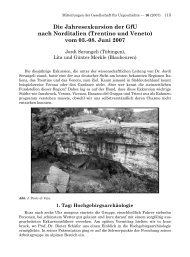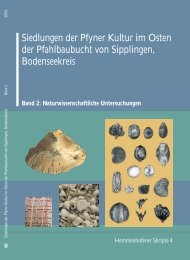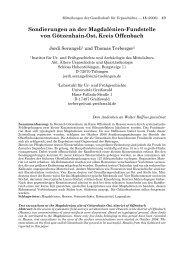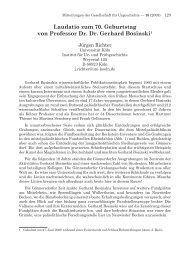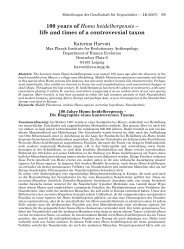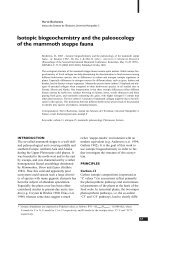bronze age environment and economy in the troad - Universität ...
bronze age environment and economy in the troad - Universität ...
bronze age environment and economy in the troad - Universität ...
You also want an ePaper? Increase the reach of your titles
YUMPU automatically turns print PDFs into web optimized ePapers that Google loves.
chapter 3: analysis<br />
emmer. Heliotropium europaeum, Trifolium sp. <strong>and</strong> Eleocharis<br />
uniglumis/palustris are amongst <strong>the</strong> most abundant wild plants.<br />
Hulled wheat chaff <strong>and</strong> gra<strong>in</strong> form <strong>the</strong> majority of sample<br />
BP13. Barley <strong>and</strong> lentil are also represented, <strong>and</strong> Heliotropium<br />
<strong>and</strong> Eleocharis are aga<strong>in</strong> amongst <strong>the</strong> most abundant wild<br />
plants.<br />
The sample from a floor horizon (BP14, n=280) was<br />
dom<strong>in</strong>ated by <strong>the</strong> crop legume bitter vetch. Lathyrus<br />
sativus/cicera occurred as a constant weed f<strong>in</strong>d <strong>in</strong> bitter vetch<br />
samples. A few o<strong>the</strong>r weeds <strong>and</strong> emmer <strong>and</strong> e<strong>in</strong>korn gra<strong>in</strong><br />
were found.<br />
The lowest sample (BP18) was <strong>the</strong> poorest <strong>in</strong> rema<strong>in</strong>s <strong>and</strong> was<br />
composed ma<strong>in</strong>ly of emmer chaff, Trifolium sp. <strong>and</strong> Phalaris<br />
spp. It was probably part of a deposit of crop-process<strong>in</strong>g byproducts.<br />
Dur<strong>in</strong>g <strong>the</strong> Middle Bronze Age, all <strong>the</strong> traditional<br />
Mediterranean crops were cultivated at Troy, except for chick<br />
pea, olive <strong>and</strong> millet. This period <strong>the</strong>refore has <strong>the</strong> broadest<br />
range of crops of all <strong>the</strong> periods under study. Possible<br />
explanations for this are given <strong>in</strong> chapter 5.<br />
3.1.2.4 Late Bronze Age build<strong>in</strong>gs <strong>and</strong> ditches<br />
around <strong>the</strong> Lower City of Troy<br />
Beside <strong>the</strong> well-known ditch with its gateway lead<strong>in</strong>g directly<br />
<strong>in</strong>to <strong>the</strong> Lower City of Troy VI (Figure 8), a similar Troy VI<br />
ditch, c. 80-100 m south of <strong>the</strong> former ditch, was recently<br />
discovered. It encircles an even larger area, <strong>and</strong> is also thought<br />
to have been part of <strong>the</strong> system of defences. These ditches were<br />
dug <strong>in</strong>to <strong>the</strong> bedrock <strong>and</strong> would have been considerable<br />
barriers, e.g. <strong>in</strong> times of war. Dur<strong>in</strong>g peacetime, <strong>the</strong> area<br />
between <strong>the</strong> two ditches might have been used for graz<strong>in</strong>g<br />
livestock, stabl<strong>in</strong>g for <strong>the</strong> horses, for thresh<strong>in</strong>g-floors or a<br />
market place (Korfmann 1996).<br />
The Troy VI ditch was excavated at a po<strong>in</strong>t 400 m south of <strong>the</strong><br />
Troy VI fortification wall. Accumulation horizons with<strong>in</strong> <strong>the</strong><br />
3 m wide ditch were sampled. The analysis of a representative<br />
sample was published <strong>in</strong> 1994 (Jablonka, König <strong>and</strong> Riehl<br />
1994). In <strong>the</strong> follow<strong>in</strong>g years, fur<strong>the</strong>r samples from this ditch<br />
have broadened <strong>the</strong> range of possible functions <strong>and</strong> <strong>the</strong><br />
conditions of deposition.<br />
The sample BP03 from trench A29 was taken from an<br />
accumulation of carbonised material, while BP05 from trench<br />
y29 came from a s<strong>and</strong>y deposit <strong>in</strong> <strong>the</strong> gate area, which<br />
conta<strong>in</strong>ed large numbers of animal bones <strong>and</strong> ceramic sherds<br />
(Figure 8).<br />
In general, <strong>the</strong> samples from deposits, described as ‛burnt<br />
layers’ had <strong>the</strong> best preserved <strong>and</strong> most abundant rema<strong>in</strong>s,<br />
whereas <strong>in</strong> samples from s<strong>and</strong>y layers <strong>the</strong> rema<strong>in</strong>s were sparse<br />
<strong>and</strong> badly preserved, which po<strong>in</strong>ts to <strong>the</strong> higher ‛<strong>in</strong>put’ of<br />
rema<strong>in</strong>s <strong>in</strong> ‛burnt sediment’, <strong>and</strong> <strong>the</strong> mechanical destruction of<br />
rema<strong>in</strong>s <strong>in</strong> s<strong>and</strong>y sediment.<br />
BP03 (n=655) had a species composition similar to <strong>the</strong> samples<br />
mentioned above, with a dom<strong>in</strong>ant broad spectrum of<br />
waterplants <strong>and</strong> species characteristic of open vegetation. The<br />
only crop rema<strong>in</strong>s were from grape, fig <strong>and</strong> gra<strong>in</strong> legumes.<br />
Although <strong>the</strong> excavators doubt that <strong>the</strong> ditch was filled with<br />
water, conditions <strong>in</strong> <strong>the</strong> ditch must have been moist for at least<br />
part of <strong>the</strong> year. Amongst <strong>the</strong> moisture-<strong>in</strong>dicat<strong>in</strong>g plants are<br />
Alisma cf. gram<strong>in</strong>eum, Typha latifolia, Eleocharis<br />
uniglumis/palustris, Cyperus longus, <strong>and</strong> Scirpus maritimus.<br />
Most of <strong>the</strong>se plants do not need to be cont<strong>in</strong>uously<br />
submerged, <strong>and</strong> are able to survive on seasonally flooded<br />
ground. It seems unlikely that <strong>the</strong>se plants where thrown <strong>in</strong>to<br />
<strong>the</strong> ditch by <strong>the</strong> <strong>in</strong>habitants toge<strong>the</strong>r with <strong>the</strong> fruit rema<strong>in</strong>s. It is<br />
suggested <strong>the</strong>refore, that water collected <strong>in</strong> parts of <strong>the</strong> ditch,<br />
where <strong>the</strong> bedrock was less permeable. These were optimal<br />
areas for <strong>the</strong> development of <strong>the</strong> moisture-lov<strong>in</strong>g plants. From<br />
time to time <strong>the</strong>y might have been uprooted <strong>and</strong> burned by <strong>the</strong><br />
<strong>in</strong>habitants. The weeds (ma<strong>in</strong>ly Chenopodietea members)<br />
might have been deposited <strong>in</strong> <strong>the</strong> same way as <strong>the</strong> seeds of<br />
grape <strong>and</strong> fig. O<strong>the</strong>r wild plants, which were formerly often<br />
found <strong>in</strong> animal dung contexts, were also very abundant. It is<br />
not difficult to imag<strong>in</strong>e that various k<strong>in</strong>ds of waste material<br />
ended up <strong>in</strong> this ditch <strong>and</strong> were accumulated <strong>and</strong> re-deposited<br />
with <strong>the</strong> seasonal flow of water.<br />
O<strong>the</strong>r deposits were poorer <strong>in</strong> rema<strong>in</strong>s. Sample BP05 (n= 84),<br />
from a s<strong>and</strong>y layer from <strong>the</strong> end of <strong>the</strong> ditch (close to <strong>the</strong> gate;<br />
trench y29), conta<strong>in</strong>ed no water plants, but did <strong>in</strong>clude rema<strong>in</strong>s<br />
from cereal process<strong>in</strong>g <strong>and</strong> o<strong>the</strong>r crops. The spectrum<br />
corresponds to those of o<strong>the</strong>r Late Bronze Age samples.<br />
This sample, <strong>and</strong> also o<strong>the</strong>rs from <strong>the</strong> second, outer ditch<br />
(g28BP01), where rema<strong>in</strong>s from cereal-process<strong>in</strong>g were also<br />
found, support <strong>the</strong> suggestion that <strong>the</strong> space between <strong>the</strong> two<br />
ditches was used for thresh<strong>in</strong>g. Unlike samples from <strong>the</strong> <strong>in</strong>ner<br />
ditch, <strong>the</strong> outer ditch samples conta<strong>in</strong> Chara oogonia <strong>in</strong><br />
abundance. In contrast to <strong>the</strong> water plants from <strong>the</strong> <strong>in</strong>ner ditch,<br />
<strong>the</strong>se algae need to be cont<strong>in</strong>uously submerged <strong>in</strong> order to<br />
survive. Ei<strong>the</strong>r <strong>the</strong>re was more water <strong>in</strong> <strong>the</strong> outer ditch, or <strong>the</strong>se<br />
rema<strong>in</strong>s have come from elsewhere <strong>in</strong> <strong>the</strong> settlement.<br />
In 1991 an area directly adjo<strong>in</strong><strong>in</strong>g <strong>the</strong> Troy VI fortification<br />
wall was excavated (Easton <strong>and</strong> Wen<strong>in</strong>ger 1993, Korfmann<br />
1992a, 1992b). An apsidal house with a stor<strong>age</strong> structure was<br />
situated above <strong>the</strong> rema<strong>in</strong>s of an oven. The apsidal house is<br />
already part of <strong>the</strong> Lower City. The seriation of <strong>the</strong> pottery<br />
embraces a period of 300 years from c. 1700 to 1400 BC<br />
(Easton <strong>and</strong> Wen<strong>in</strong>ger 1993). N<strong>in</strong>e archaeobotanical samples<br />
were taken from this area; five are discussed below.<br />
The ma<strong>in</strong> components of <strong>the</strong> samples from this trench were<br />
barley, emmer, bitter vetch <strong>and</strong> water plants. The two samples<br />
with <strong>the</strong> most water plants (BP01, n=261; BP02, n=91) are<br />
stratigraphically <strong>the</strong> most recent from this build<strong>in</strong>g.<br />
The ma<strong>in</strong> portion <strong>in</strong> BP01 is <strong>the</strong> m<strong>in</strong>eralised form of<br />
Eleocharis uniglumis/palustris. O<strong>the</strong>r rema<strong>in</strong>s like emmer<br />
gra<strong>in</strong> <strong>and</strong> chaff are only sparsely recorded. The <strong>in</strong>terpretation<br />
of <strong>the</strong> m<strong>in</strong>eralised seeds is difficult, but with a maximum<br />
grow<strong>in</strong>g height of 70 cm, <strong>the</strong> sedge might have been used for<br />
build<strong>in</strong>g purposes. In this case, <strong>the</strong> way <strong>the</strong>y became<br />
m<strong>in</strong>eralised is unknown. Ano<strong>the</strong>r explanation may be that<br />
sedges were eaten by animals <strong>and</strong> <strong>the</strong> seeds are derived from<br />
dung, but, as <strong>the</strong> relationship between animal digestion <strong>and</strong> <strong>the</strong><br />
m<strong>in</strong>eralisation of plant rema<strong>in</strong>s is unknown, this idea is not<br />
favoured here.<br />
BP02 is similar <strong>in</strong> composition with fewer m<strong>in</strong>eralised<br />
Eleocharis seeds <strong>and</strong> more weeds. The rema<strong>in</strong>s from <strong>the</strong>se two<br />
samples are generally very similar to those from <strong>the</strong> ditch, <strong>and</strong><br />
probably reflect, with <strong>the</strong> ubiquitous grape <strong>and</strong> fig seeds, a<br />
33







